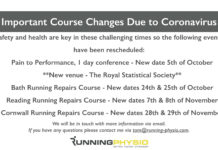PhD candidate Marco Altini is clearly a man with impeccable timing!… I’d literally just finished perusing some research on the use of heart rate variability in training when his email, on this very topic, arrived in my inbox! Marco has created an app utilising technology most of us have in our phones to help guide athletes with their training. He’s kindly agreed to tell us about his app and how it works…
Heart rate variability (HRV) is an important marker providing insights into an individual’s physiological stress level, helping athletes and sport enthusiasts monitoring training load and optimizing performance. With apps like HRV4Training, HRV can be computed accurately without the need for any external sensor or device, making it very easy for everyone to benefit from this technique.
How Does HRV Work?
The cardiovascular system is mostly controlled by autonomic regulation through the activity of sympathetic and parasympathetic pathways of the autonomic nervous system and analysis of HRV permits us to understand this control mechanism. Several studies on HRV [1,2] highlighted how different features can provide insights on autonomic regulation and especially on parasympathetic activity, the branch of the nervous system mainly responsible for the body’s resting functions.
Simply put, monitoring parasympathetic activity via HRV can provide insights on physiological stress, with higher level of stress resulting in lower HRV. For example, in the context of sports, heavy training is responsible for shifting the cardiac autonomic balance toward a predominance of the sympathetic over the parasympathetic drive. This means that heavy training will typically reduce HRV and by monitoring HRV we can optimize training, reduce the risk of overtraining and ultimately improve performance.
Getting Your HRV Data
Up to a few years ago, HRV was used mainly by elite athletes and coaches or academic researchers working at the intersection of sports, fitness, health and medicine. Many of these experts were able to show links between HRV and performance as well as recovery or training load.
However, in the recent past, many new, affordable and user-friendly tools have been developed. These tools typically rely on commercially available heart rate monitors (e.g. a Polar chest strap) to analyze data, compute HRV and provide guidance to the user. The latest developments go even a step further. With apps like HRV4Training, HRV can be computed accurately directly from your smartphone.
HRV4Training
HRV4Training uses the phone camera to extract photoplethysmography (PPG, basically blood flow from the finger) and then determine markers of the autonomous nervous system activity, in particular, parasympathetic activity. The technique has been clinically validated and proved to be a reliable measurement, as good as standard electrocardiograms with sticky gel electrodes [3,4,5].
By quantifying parasympathetic activity the app is able to translate the information into an assessment of training load and provide actionable insights on physical condition, helping users to better understand how their body responds to training and other important factors in life (e.g. sleep, stress, etc.) [6,7,8,9]
From Data to Actionable Insights
Even with the right tools, HRV can be difficult to gather under the right conditions and challenging to interpret. When should you measure? How often? What does the data mean?
HRV4Training makes it much easier, by suggesting when to take the measurement, typically early morning, and guiding you through a paced breathing exercise.
Most importantly, once you have taken your measurement, HRV4Training will interpret the measurement for you, by analyzing it in the context of your own baseline, and giving you personalized advice on today’s training. Should you push it or take it easy?
HRV4Training lets you annotate a few extra parameters such as sleep, muscle fatigue, etc., and shows you historical data as well as trends that can help you better understand your physical condition for both the day-to-day training and over the long run.
For questions/inquiries/feedback about HRV4Training, just drop a line to @marco_alt on Twitter or visit the HRV4Training blog.
References:
[1] Sztajzel, Juan. “Heart rate variability: a noninvasive electrocardiographic method to measure the autonomic nervous system.” Swiss medical weekly 134 (2004): 514-522.
[2] Thayer, Julian F., Shelby S. Yamamoto, and Jos F. Brosschot. “The relationship of autonomic imbalance, heart rate variability and cardiovascular disease risk factors.” International journal of cardiology 141.2 (2010): 122-131.
[3] Russoniello, C. V., et al. “A measurement of electrocardiography and photoplethysmography in obese children.” Applied psychophysiology and biofeedback 35.3 (2010): 257-259.
[4] Lu, Sheng, et al. “Can photoplethysmography variability serve as an alternative approach to obtain heart rate variability information?.” Journal of clinical monitoring and computing 22.1 (2008): 23-29.
[5] HRV4Training Blog: http://www.hrv4training.com/blog/heart-rate-variability-using-the-phones-camera
[6] Garet, Martin, et al. “Individual interdependence between nocturnal ANS activity and performance in swimmers.” Medicine and science in sports and exercise 36 (2004): 2112-2118.
[7] Pichot, Vincent, et al. “Relation between heart rate variability and training load in middle-distance runners.” Medicine and science in sports and exercise 32.10 (2000): 1729-1736.
[8] Kiviniemi, Antti M., et al. “Endurance training guided individually by daily heart rate variability measurements.” European journal of applied physiology 101.6 (2007): 743-751
[9] Myllymäki, Tero, et al. “Effects of exercise intensity and duration on nocturnal heart rate variability and sleep quality.” European journal of applied physiology112.3 (2012): 801-809.











